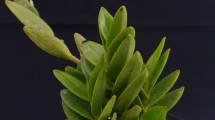Abstract
The effects of salinity (10 and 50% seawater) and oil in combination on three mangroves, Avicennia marina, Bruguiera gymnorrhiza, and Rhizophora mucronata, were investigated. In all species, plant height, number of leaves, and CO2 exchange were generally higher in 10% than in 50% seawater. Salinity and oil decreased plant height, number of leaves, chlorophyll content, and CO2 exchange, with reductions being greater at the higher salinity. In a second experiment, the effects of salinity (0, 10, and 50% seawater) and oil on concentrations of ions, polycyclic aromatic hydrocarbons (PAHs), leaf ultrastructure, and salt secretion in A. marina were investigated. Salinity and oil in combination increased concentrations of Na+ but decreased those of K+, Ca2+, and Mg2+. PAHs caused damage to cell membranes, disrupted ion concentrations, and reduced salt secretion. This study demonstrated that increase in salinity reduces growth of mangroves and that salinity and oiling in combination exacerbate growth reduction. In A. marina, oil was absorbed and translocated to the leaves where it disrupted membranes, ion accumulation, and salt secretion.




Similar content being viewed by others
References
Alkio M, Tabuchi TM, Wang X, Carmona CA (2005) Stress responses to polycyclic aromatic hydrocarbons in Arabidopsis include growth inhibition and hypersensitive response-like symptoms. J Exp Bot 56:2983–2994
Ball MC (1988) Ecophysiology of mangroves. Trees 2:129–142
Barbier EB (2016) The protective service of mangrove ecosystems: a review of valuation methods. Mar Pollut Bull 109:676–681
Cavalcante RM, Sousa FW, Nascimento RF, Silveira ER, Freire GSS (2009) The impact of urbanization on tropical mangroves (Fortaleza, Brazil): evidence from PAH distribution in sediments. J Environ Mgmt 91:328–335
Friess DA (2016) Ecosystem services and disservices of mangrove forests: insights from historical colonial observations. Forests 7:183–199
Gilfillan ES, Page DS, Bass AE, Foster JC, Fickett PM, Ellis WG, Rusk S, Brown AC (1989) The use of Na–K ratios in leaf tissues to determine effects of petroleum on salt exclusion in marine halophytes. Mar Pollut Bull 20:272–276
Gordon DM (1993) Diurnal water relations and salt content of two contrasting mangroves growing in hypersaline soils in tropical-arid Australia. In: Leith H, Masoom A (eds) Towards the rational use of high salinity tolerant plants, vol 1. Kluwer Academic Publishers, Netherlands, pp 193–216
Ke L, Zhang C, Wong YS, Tam NFY (2011) Dose and accumulative effects of spent lubricating oil on four common mangrove plants in South China. Ecotoxicol Environ Saf 7:55–66
Lewis M, Pryor R, Wilking L (2011) Fate and effects of anthropogenic chemicals in mangrove ecosystems: a review. Environ Pollut 180:345–367
Li F, Zen X, Yang J, Zhou K, Zan Q, Lei A, Tam NFY (2014) Contamination of polycyclic aromatic hydrocarbons (PAHs) in surface sediments and plants of mangrove swamps in Shenzhen, China. Mar Pollut Bull 85:590–596
Naidoo G, Naidoo K (2017) Ultrastructural effects of polycyclic aromatic hydrocarbons in the mangroves Avicennia marina and Rhizophora mucronata. Flora 235:1–9
Naidoo G, Naidoo Y, Achar P (2010) Responses of the mangroves Avicennia marina and Bruguiera gymnorrhiza to oil contamination. Flora 205:357–362
Parida AK, Jha B (2010) Salt tolerance mechanisms in mangroves: a review. Trees 24:199–217
Reynolds ES (1963) The use of lead citrate at high pH as an electron opaque stain in electron microscopy. J Cell BioI 17:208–212
Saintilan N, Wilson NC, Rogers K, Rajkaran A, Krauss KW (2014) Mangrove expansion and salt marsh decline at mangrove poleward limits. Glob Chang Biol 20:147–157
Spurr AR (1969) A low-viscosity epoxy resin embedding medium for electron microscopy. J Ultrastruct Res 26:31–43
Suprayogi B, Murray F (1999) A field experiment of the physical and chemical effects of two oils on mangroves. Environ Exp Bot 42:221–229
Takemura T, Hanagata N, Sugihara K, Baba S, Karube I, Dubinsky Z (2000) Physiological and biochemical responses to salt stress in the mangrove, Bruguiera gymnorrhiza. Aquat Bot 68:15–28
United States Environmental Protection Agency (2008) Polycyclic aromatic hydrocarbons (PAHs). Office of Solid Waste, Washington, DC
Veldkornet D, Rajkaran A, Paul S, Naidoo G (2020) Oil induces chlorophyll deficient propagules in mangroves. Mar Pollut Bull 150:110667
Waisel Y, Eshel A, Agami M (1986) Salt balance of leaves of the mangrove Avicennia marina. Physiol Plant 67:67–72
Wang Y, Zhu H, Tam NFY (2014) Effect of a polybrominated diphenyl ether congener (BDE-47) on growth and antioxidative enzymes of two mangrove plant species, Kandelia obovata and Avicennia marina, in South China. Maine Pollut Bull 85:376–384
Ye Y, Tam NFY (2007) Effects of used lubricating oil on two mangroves Aegiceras corniculatum and Avicennia marina. J Environ Sci 19:1355–1360
Ye Y, Tam NFY, Lu CY, Wong YS (2005) Effects of salinity on germination, seedling growth and physiology of three salt secreting mangrove species. Aquat Bot 83:193–205
Youssef T, Ghanem A (2002) Salt secretion and stomatal behaviour in Avicennia marina seedlings fumigated with the volatile fraction of light Arabian crude oil. Environ Pollut 116:215–223
Zhang CG, Leung KK, Wong YS, Tam NFY (2007) Germination, growth and physiological responses of mangrove plant (Bruguiera gymnorrhiza) to lubricating oil pollution. Environ Exp Bot 60:127–136
Acknowledgements
The authors are grateful to A Rajh for technical assistance.
Availability of data and materials
The datasets used and/or analysed during the current study are available from the corresponding author on reasonable request.
Funding
This research was supported by the National Research Foundation and the University of KwaZulu-Natal (grant number 93560 to G Naidoo).
Author information
Authors and Affiliations
Contributions
GN and KN contributed equally to the experimental design, data collection, interpretation, and discussion of the results and writing of the manuscript.
Corresponding author
Ethics declarations
Ethics approval and consent to participate
Not applicable.
Consent for publication
Not applicable.
Competing interests
The authors declare no competing interests.
Additional information
Responsible Editor: V. V.S.S. Sarma
Publisher’s note
Springer Nature remains neutral with regard to jurisdictional claims in published maps and institutional affiliations.
Rights and permissions
About this article
Cite this article
Naidoo, G., Naidoo, K. Salinity exacerbates oil contamination effects in mangroves. Environ Sci Pollut Res 28, 68398–68406 (2021). https://doi.org/10.1007/s11356-021-15450-9
Received:
Accepted:
Published:
Issue Date:
DOI: https://doi.org/10.1007/s11356-021-15450-9




